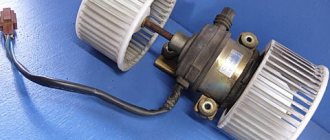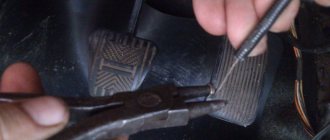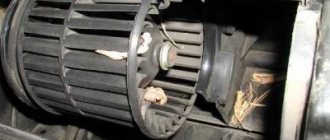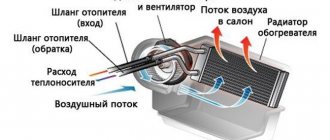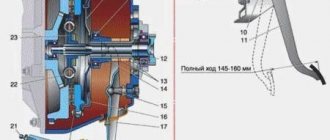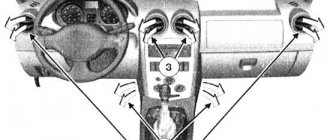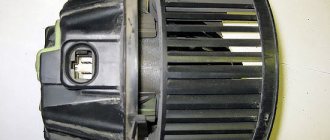Reasons why the stove in Gazelle Business does not heat. Fix it yourself
Any violation of the operating regime and, as a result, the stove in Gazelle Business does not heat.
But more often than not, the heater stops working properly for no apparent reason. For example, when power is applied, the fan turns on and blows warm air, but as soon as you start the engine and heater, it either turns off completely or blows cold air. On new cars, the stove may fail after a few weeks.
The stove in the Gazelle Business does not heat for reasons not directly related to its design. For example, if the thermostat malfunctions, or if there is a failure in the on-board power supply system.
Diagnostics and repair
The design of the heater is thought out in such a way that in order to check the functionality of any of its parts, not to mention diagnostics, it is necessary to completely remove the entire heater body and disassemble it, having previously dismantled the entire front panel in the cabin.
Without removing the dashboard, only the radiator can be replaced, because it can be accessed through the glove compartment
.
As one of the drivers put it, in order to replace the same faucet damper motor, you need to “pick up a bucket of screws” while removing the front panel.
check the electric damper drive by ear
. When the power is turned on and the temperature setting knob is turned, the sound of the gear motor operating should be heard. In extreme cases, when the gear motor fails on the road and it is necessary to direct air to the windows, it is necessary to remove the rod from the damper and set it to the required position manually.
System modernization
The main problem that causes electronics to fail is moisture. And in the tap the liquid circulates constantly, even when the shutter is closed. And when the oil seal leaks, liquid floods the entire electrical part, and it fails.
Installation of shut-off valves
To avoid this, you can install conventional shut-off valves, fitting them to the outlets of the cooling system. But in order to open or close the supply of hot liquid, you need to move the tap to the desired position manually. And since it is installed under the hood (in a regular place), it is not possible to do this while driving. But this mechanism has a much greater resource.
Pre-sealing
Before installing a new electric faucet, you need to disassemble it and fill the electronic board with hot glue to avoid moisture getting on it, coat all joints with sealant. This method can only prolong performance, because if liquid gets into the electronic part, the electric motor will be damaged, without which the mechanism will not be able to function correctly.
Design
On the Gazelle Business, the control of the interior heating system is combined and is carried out both manually using levers and using push-button control from the instrument panel.
The heating operation scheme is standard - air enters through the frontal air intakes by being sucked in by a fan with an electric motor, after which it passes through a system of deflectors and enters directly into the car cabin.
Coolant flow into the heater radiator
is controlled by a damper, the angle of which is driven by an electric motor. The electric motor of the damper drive is Italian-made, which does not at all guarantee against its breakdown, which often happens to it on this Gazelle brand.
Engine control
The damper tap is operated in automatic mode and depends on the set air temperature at the outlet. The design of the stove also includes a damper, which is controlled by an electrically driven gearmotor and can direct part of the air flow bypassing the radiator.
This is one of the main differences between the heater of the Business model and later Gazelles, on which the angle of the dampers was changed using a cable system.
The imperfection and ill-conceived design of the heater leads to the fact that when the stove on a Gazelle Business does not heat, it takes a long time to look for the cause of the malfunction. If the car is under warranty, the best option would be to contact a service station.
Heater Gazelle business device.
The tap is controlled automatically by the heater control unit depending on the selected temperature. In addition, the temperature of the air supplied to the cabin is regulated by a central damper, which, by turning, directs the air flow, or part of it, through or bypassing the radiator.
In addition to the central damper, there are a number of dampers that redistribute the air flow. The dampers of the Gazelle Business heater, unlike previous models, are controlled by gear motors, not cables. The control is carried out by the heater control unit. The electric heater fan is located inside the housing and to access it it is necessary to remove and disassemble the entire heater. Despite the fact that the fan electric motor is imported, this arrangement completely negates all the advantages of the heater.
The speed of the electric motor is regulated smoothly by turning the handle on the control unit, due to the electronic regulator located on the heater body. To access it, as well as access to almost all elements
heater, it is necessary to remove the front panel completely. The only thing that can be changed without removing the panel is the heater core. To change it, just remove the glove compartment.
Quick replacement of the engine speed controller for the gazelle business stove
Problem and arrangement for a gazelle business stove
.
The stove does not work on a gazelle business
I found the reason for the failure of the interior heating motor.
How to make the stove on a Gazelle Business heat well
The heater is one of the components of the engine cooling system. It provides an influx of fresh air heated to a predetermined temperature into the car interior, making the trip more comfortable for the driver and passengers. All the charm of its work can be felt during the cold season, when the thermometer drops below zero. But, like any mechanism, it has its own resource, which eventually ends. But it can be extended by carrying out regular preventive maintenance.
How to prevent the operation of the stove
Before the onset of cold weather, it is recommended to check the functionality of the heating and cooling system on the Gazelle, and, if necessary, carry out comprehensive repairs. To do this, you can start by removing the radiator with the motor, cleaning and lubricating them. A malfunction in the heater motor itself may be indicated by a burning smell when turned on. It most likely will not be possible to repair it - you will have to replace it with a new one. The connection diagram will help you perform the installation correctly. In addition to the smell, malfunctions may also be indicated by such signs as creaking, whistling and crackling, as well as other extraneous noises.
- Heater for Lada Granta - troubleshooting methods and instructions for replacing the device
The first thing you should pay attention to is the operation of the electric motor. It directly affects the intensity and power of the air flow created. However, when purchasing, you must also pay attention to the number of revolutions, which it is advisable to maintain around 3000 per minute. A switch should be provided to select the flow level - low, medium and high.
In addition to the engine, a number of components, instruments and parts are responsible for heating and comfortable temperature inside the Gazelle elephant. These are fans with radiators, dampers with valves, lines, filter elements and others that can affect the operation of the stove. The heater core is hidden behind the vehicle's center console. It is difficult to check its condition visually, and dismantling it and replacing it with a new one may require several hours of fiddling.
This unit is very sensitive to any contamination: external and internal. After several seasons of operation, its ribs become clogged with dirt and dust, forming deposits on the walls. This impairs the efficiency of the entire system - the volume of air flow decreases, and with it the temperature in the cabin.
A faulty thermostat in a Gazelle will never provide a comfortable temperature, no matter what type of stove is installed. When the engine warms up, it is he who sends antifreeze through the small circle, and the large one will connect when it warms up to operating values. The pump is another important component that circulates coolant through the circuits of the cooling system. A common cause of malfunction is a broken water pump impeller. The circuit itself must be closed, like a closed system. If air from the outside gets into it, then the phenomenon of airing occurs and the stove stops heating normally.
In order to carry out repairs as efficiently as possible and with minimal investment, you need to know how the heater and cooling/heating system on Gazelle cars work. Most faults can be easily diagnosed and prevent failure of the entire system.
The heating system for GAZelle GAZ-3302 and GAZ-2705 is designed for continuous operation for a long time. It provides multiple exchanges of air in the cabin and the required air temperature in the cold season.
Operating principle of the heater
A side effect of the engine is heat, which is generated due to fuel combustion and friction of parts. Heat is removed from highly hot parts by the engine cooling system through coolant. It moves along the highways and, having given off heat to the atmosphere, returns back to the internal combustion engine. The coolant movement is provided by a water pump (pump), which operates from the crankshaft pulley via a belt drive. Also, on models with two heaters, an additional electric pump is installed for better coolant circulation throughout the system. To quickly warm up the engine, the system has two circuits (small and large). Between them there is a thermostat, which opens the passage to the large circuit when the coolant reaches the temperature to which it is set. The large circuit has a radiator in its circuit that quickly cools the hot liquid. The heater is included in a small circuit. When operating correctly on a warm engine, the heater blows warm.
The Gazelle Business heater consists of a housing, air ducts with dampers, a radiator, a fan with an impeller, a faucet and a control unit. Hot coolant from the engine enters the stove through the pipes and returns back after heat transfer. For better efficiency, the heater is equipped with an electric motor with an impeller, which blows cold air through the radiator honeycombs and, passing through a heated radiator, the air heats up and enters the cabin already hot. The dampers can be used to direct the flow in the direction we need (on the glass, on the legs, on the face). The temperature is regulated by a tap, which passes a given amount of coolant through the stove. All adjustments are made from the control unit.
Diagnostics
There can be many reasons why the Gazelle Business stove does not work. And for a successful repair, you must first identify the cause of the malfunction, and only then begin to eliminate it:
- The first step is to check the coolant level in the expansion tank. A low coolant level leads to the formation of an air plug in the cooling system, and since the heater is the highest point, the “plug” will be there.
- Next, you need to check the coolant temperature. During the cold season, the engine cools down rapidly before it has time to reach temperature. The temperature sensor may be faulty and show an incorrect temperature value.
- Then you need to check the cabin radiator; it is clogged and may not allow a sufficient amount of coolant to pass through it. You can check this by testing the inlet and outlet pipes; they should be approximately the same temperature. If the inlet pipe is hot and the outlet is cold, then the reason is a clogged radiator.
- If the inlet pipe is also cold, then you need to try the pipe that goes to the radiator from the engine compartment to the tap. If it is hot, then the problem is that the faucet is not working.
- Well, if the pipe to the faucet is cold, then there are more options
- The first thing to check is the thermostat. This can be done with the engine running but not warmed up. We start it and test the surface before and after the thermostat. The surface must be heated before the thermostat, and afterward it must remain cold. If the pipe after the thermostat heats up, then the problem is in the thermostat.
- pump is faulty. It either jammed, or the shaft burst, or the pump impeller became unusable. The fluid does not circulate well through the system, and because of this, the heater may blow cold.
- The gasket between the block and the cylinder head is broken. This malfunction also affects the operation of the heater and the entire engine as a whole. It is accompanied by clouds of white steam from the exhaust pipe and a decrease in coolant in the cooling system. In some cases, antifreeze may be released from the expansion tank.
After diagnostics, we begin repairs:
- If the coolant level is below the minimum mark, then it must be brought to normal, having first eliminated fluid leaks, if any. It is possible to remove the plug by pushing the pipes along their entire length with the engine running. Or by placing the front of the car downhill and increasing the engine speed to 3,000 rpm. There is also a way to pump the system with air pressure. You need to remove the upper pipe from the expansion tank and lower it into an empty canister. Next, bring the coolant level to the full tank and, by connecting a hand pump to the vacated fitting, pump air into the tank to the lower mark. Then drain the antifreeze from the canister back into the tank and repeat the procedure. This should be repeated 2 – 3 times.
- If the pipes are barely warm and the sensor shows 90° C, then most likely either it or the temperature gauge itself is faulty. They need to be replaced. In extreme cold (more than -20), you can close part of the radiator (no more than 50%), then the engine will heat up better and cool down more slowly.
- To repair the radiator, it must be removed and washed. If washing does not bring results, then you need to replace it with a new one.
- The faucet may not work due to the drive, or the locking mechanism itself may be faulty. On the Gazelle Business, the faucet turns the electric drive. Therefore, you need to first check the drive, and if it is working, start replacing the faucet. It either does not open completely or is completely stuck in one position, and this can cause a cold air flow.
- To replace the thermostat, you need to drain the coolant, unscrew the cap and replace it with a new one, since this mechanism cannot be repaired.
- The pump also needs to be dismantled and replaced with a new one. This is a very important element, and due to its incorrect operation, the entire engine may fail, since coolant circulation is disrupted and heat cannot be effectively removed from highly heated parts. And, as a result, they overheat and become deformed.
- The worst thing that can happen in a broken gasket is water hammer. When the piston tries to compress the liquid, an increased load is placed on all the internal combustion engine mechanisms, which leads to failure of the entire engine, so such a malfunction must be corrected immediately. In this case, it is prohibited to continue moving using engine power. Such repairs are carried out only with the involvement of specialists, since the cylinder head needs to be grooved; everything else can be done on your own.
Main possible malfunctions
To accurately determine why the gazelle stove does not heat or does not work efficiently enough, diagnostic measures should be carried out.
Practice clearly shows that there are several reasons and factors due to which the heater stops blowing or simply does not work at full capacity from time to time.
The most common malfunctions of the heating system on Gazelle cars are associated with:
- electric fan;
- coolant;
- thermostat;
- radiator;
- water pump;
- cylinder head gasket.
In order for the heating system to start blowing hot air again and under high pressure, depending on the set regulator on the control panel, appropriate work must be carried out to eliminate the identified faults.
Let's take a look at why the stove may not work on a Gazelle at times and how to solve this or that problem.
Heater fan
A fairly banal, but at the same time very common reason. The heater itself works if the fan is faulty, but the impeller cannot supply hot air under pressure into the cabin.
If the heater is functioning, but the fan does not rotate, as a result of which hot air barely enters the cabin, or does not reach the cabin at all, you need to check the condition of the electric fan.
Depending on the specific modification of the Gazelle, access to the fan may require complex dismantling work, dismantling almost the entire dashboard and panel, or unscrewing just a few screws.
In addition to the fan motor itself, the fault for its failure may lie in the electronics, broken wires, and a fuse that often blows.
Coolant
The Gazelle car uses a liquid engine cooling system, and therefore antifreeze or antifreeze plays a huge role in the operation of the heater.
The question may be not only about quality, but also, first of all, about quantity. You will be surprised how often the failure of the stove is due to the fact that there is simply too little liquid left in the tank. This is due to its natural consumption during operation, or to the appearance of other reasons that provoked the loss of coolant (radiator leak, breakdown in pipes, leakage of the tank, etc.).
As a result, an insufficient amount of hot antifreeze enters the heater, the heater radiator remains cold or barely warm, which is why the fan is left to pump unheated air into the cabin.
Check the amount of coolant in the tank, add as necessary. After a while, check again how much liquid is left there. If the level drops quickly again, you need to find the leak.
When pouring new coolant into the Gazelle or after carrying out certain repairs that require draining the antifreeze and returning it to its place, air locks may form in the system.
Heater radiator
Another common cause of poor heater performance can be its radiator. Not to be confused with the engine cooling radiator.
There are several reasons for this:
- Antifreeze of different brands and manufacturers was mixed incorrectly.
- The concentrate was diluted incorrectly. There are certain proportions for it that cannot be violated.
- Instead of full-fledged antifreeze, they filled it with ordinary water. It contributes to clogging of the radiator channels and its rapid failure.
- There could be a leak in the radiator. There are many reasons, including normal wear and tear.
- To eliminate leaks, sealants were used, which in practice do more harm than good.
If the heater radiator is clogged, it makes sense to try flushing it. If a leak is detected, you will almost certainly have to remove the old radiator and install a new one on the Gazelle.
Thermostat
Very often on Gazelle cars, as on many other cars, poor performance of the interior heating system is associated with a malfunction of the thermostat.
This is a rather complex problem that will require more effort, time and money to resolve. If the heater itself is working normally, the radiator is not leaking, the coolant is at the required level, the electric fan is rotating at the set speed, it is worth checking the engine thermostat.
The thermostat is used as a regulator of cooling circles. When the engine starts, the thermostat circulates fluid in a so-called small circle, through the engine and the interior heater. This allows the engine to warm up much faster. When the cooling liquid warms up to a certain temperature, a large cooling circle comes into operation. Then the antifreeze goes directly through the engine radiator. This prevents the motor from overheating and removes excess heat.
But over time or due to the use of low-quality coolant, the thermostat may fail. The result of a breakdown is that the large cooling circle does not close, and the liquid constantly circulates through this circuit.
Yes, in theory, you can wait until the large circle warms up and the stove starts working at normal temperature. But when the temperature outside is sub-zero, there is simply no time to wait.
The problem can be solved in one way. You need to purchase a new thermostat for your Gazelle and install it.
Water pump
In order for the liquid to circulate through the engine cooling system, while capturing the radiator of the Gazelle stove, a certain impact is required. Such tasks are performed by a water pump or simply a pump.
This is an impeller enclosed in a metal cylinder through which the cooling liquid passes. The rotation of the impeller helps to push or pump antifreeze (antifreeze) throughout the system, depending on the current circle set by the thermostat. The absence of a water pump makes the system extremely ineffective. Because of this, the motor can overheat very quickly.
There are several main malfunctions associated with the water pump of the engine cooling system, which directly affect the functioning of the interior heating:
- Sometimes the crankshaft belt breaks, through which force is transmitted and the engine rotates. As a result, the injection of coolant stops and the stove stops working. At the same time, the Gazelle engine itself is actively overheating.
- The water pump may jam. The pump itself does not rotate, or the impeller cannot rotate.
- Internal components corrode and failure occurs. This usually happens due to the use of low-quality cooling fluid, after incorrect mixing of compounds, etc. As a result, the internal impeller is literally corroded by aggressive components. In fact, the motor pulley itself rotates, but the fluid moves through the system much worse. Accordingly, the interior heater stops working properly.
Regardless of the reasons, the cooling system water pump will need to be removed. Here you can try to restore it through partial repairs. But most often a complete replacement of the unit is required.
Cylinder head gasket
We cannot exclude a situation where the stove stops working for more global reasons related to a broken engine head gasket.
After all, the motor is not monolithic in design, but consists of two main parts. This is the block itself and its head. The connection occurs using a special gasket.
But this same gasket can wear out and break through over time for one reason or another. After a breakdown, the cooling liquid begins to flow into the exhaust system, into the cylinders. When it exits into the exhaust system, the corresponding malfunction can usually be diagnosed by thick white smoke coming from the exhaust pipe.
As a result, there is simply not enough antifreeze for the system to function properly, air pockets form, and the stove stops producing enough heat.
Such a situation should be eliminated immediately upon detection. It is strictly not recommended to continue operating the Gazelle in emergency mode, otherwise the consequences could be dire, including the need for major repairs.
The stove on the gazelle business 4216 does not heat well
The owner of a long gazelle business came to us from the distant northern Urals, the city of Novy Urengoy, with a complaint about a faulty stove, he says the stove doesn’t heat at all, but he bought this workhorse second-hand the other day and didn’t check the functionality of the stove, so we need to figure out the fault. Errors E3 and E7 (E3 and E7) light up on the display.
And so, we begin the check with a visual inspection of the heater control unit (HCU) 2705-8121020. E3 lights up on the display . Looking ahead, let's say that this malfunction is associated with the heater damper gear motor (90.3780) or MP-2-01 , which is located next to the driver’s right foot under the panel. Looking under the panel and deciding to check whether both connectors were latched, we did not find this gear motor, but only the connectors were dangling. Apparently the previous owner removed the gear motor, but did not install a new one. We install a new gear motor.
Video. Checking the heater damper gear motor (90.3780) or MP-2-01 .
2 errors with this gear motor ( 90.3780 ) E3 - malfunction of the damper position sensor ( rheostat ), which determines the current position of the damper. E6 - a malfunction of the motor itself, the gear motor that controls the damper.
We check the functionality of the heater and turn on the ignition. Error E3 disappeared, but error E7 . The stove still blows cold air, although the gear motor 90.3780 is working properly. Next, we check the heater tap, because it is responsible for supplying hot coolant to the heater radiator, and it is also the reason why error E7 . We set the temperature regulator on the control unit to the hottest position and check by hand the hoses going to the heater radiator.
Both of our pipes going to the heater radiator turned out to be cold, although the pump is working and the supply hose to the faucet is hot, which means for some reason the faucet does not open. The easiest way to check the operation of the faucet is to turn the temperature control to maximum and minimum with the car turned off. The stove tap should make characteristic clicks, indicating its operation. But we didn’t hear any sounds, so we’re conducting a more detailed check. We start by checking the heater tap connector.
First, let's check the +12 volt power supply (orange tap wire, white wiring connector wire), ground (black tap wire and black connector wiring wire) and control signals arriving at the heater tap: brown tap (brown wiring connector) - heat, white tap (green connector wiring) - cold.
For clarity and to check the operation of the control unit, we will assemble a simple probe using LEDs. It will clearly show us whether cold/heat control signals are being supplied from the control unit.
If one of the control signals is missing, then you should check the wiring from the heater tap to the control unit - these are the green and brown wires. In our case, there was no control signal on the brown wire, which is responsible for the heat supply.
When the ignition is turned on and the heater tap is connected, the green and brown wires should have a voltage of about +10. +12 volts coming from the heater tap. At the time of heat/cold adjustment, a control minus should appear on one of these wires. If there is no control signal, then the control transistor in the control unit itself has burned out. To check the control transistors, you need to disassemble the climate system unit and check the control keys.
The blue transistor is responsible for switching to the cold position, the red transistor is responsible for controlling the hot position
In this circuitry, npn SMD transistors in a sot23 package are used to control the crane. To replace a non-working key, you can use any NPN transistor designed for a collector current of at least 100 mA and a voltage of at least 20 volts, for example the common transistor BC547 . Or C945, which we just found. Here is a brief diagram of a power transistor.
In our case, the red control key, which is responsible for the heat supply, was faulty.
You can replace the SMD transistor in another package, for example in TO92, but you will have to solder and bend the legs.
After replacing the faulty transistor, the heater valve began to work as it should, error E7 disappeared, and the interior of our gazelle began to warm up?
Date added: 2016-03-16
Author of the article: Alexander Dmitriev (AlastaR)
© AutoService | Online store, Ekaterinburg
I decided to share a solution to the problem of a poorly heating stove, which I encountered from the very beginning and could not solve for a long time. There is even a blog entry about this.
I even dismantled the entire interior to get to the heater mechanisms and servos. There, surprisingly, everything was in order and working correctly.
So, the problem in fact was not even a problem, but simply a hack job by the LPG installers. They powered the gearbox and the stove in series. Those. From the pump, the liquid went into the gas reducer, then into the stove.
Having removed the reducer pipes and simply blowing them with my mouth, I realized that there is serious resistance to the passage of even air. I didn’t go into detail about how my gearbox works, I’ll just say one thing: I’ve never lost gas in cold weather. On any cheap gearboxes like Alaska, below -20 the gas immediately cuts off and you have to go and insulate the gearbox in a circle. In a word, the reducer takes a fair amount of temperature from the liquid passing through it.
It was decided to “parallelize” the fluid supply to the stove and gearbox by installing two “T” shaped splitters. So that the liquid flows independently into the stove and gearbox without interfering with each other.
And the problem was completely resolved. It's hot in the car! I recommend everyone to monitor the installation of HBO, especially if it is a BRC system. Since the gearbox there has high efficiency. And if the installers skimp on pipes, don’t accept the job, you already know the reason why. Good luck to all!
I've looked through everything and can't find anything relevant to the case.
I'll explain. In May last year, 3 NEW Gazelles were purchased, mine and my friends. My friend’s and I’s stove heats very poorly, at -5 outside on the highway the stove can’t handle it, it blows weak warm air, and it’s also not very warm on site.
But another comrade from the same party has a car, BUT the stove cooks hard. At -15 he drives with the windows open - he’s damn hot. Despite the fact that half of the deflectors are closed.
Now, in order, ALL cars have:
-
the hoses leading to the heater are HOT in both directions (the pump plows correctly)
-
the valve in the engine compartment is turned off and manually switched to the “Radiator Only” mode (which directs the coolant past the heater radiator)
-
the cooling system is working properly , does not leak and no repair compounds have been used anywhere (i.e. no one’s radiators are clogged)
-
I replaced the climate control unit from the car where the stove fries - nothing has changed (the problem is not in the control unit)
Tell me where else to dig? It’s just one thing to look at the radiator (20 minutes of work) or to disassemble the ENTIRE dashboard in order to get to the heater and its servos in order to see “something” (half a day of work).
Maybe there is some kind of “defect” in the settings of the air intake dampers from the factory? They stupidly do not completely direct the air to the radiator, and let some pass by?
We really need help, as the cold is about to start getting stronger! I don’t want to travel long distances in felt boots))
Gazelle does not heat the stove while driving
I installed a Zhiguli radiator instead of mine. Gazelle 2705, 2004 onwards. The case broke during installation. The stove began to heat poorly. Although the radiator is a three-row copper radiator, the radiator and hoses are hot. The place is warm, but cool air blows as you go. What to do?
- It's very cold in the cabin, what can I do? – 1 answer
After you broke the housing and made your own changes to the design of the gazelle stove, which does not heat well from the factory, do you have a complete flow of air through the radiator? Or has a gap formed through which the air flow bypasses the radiator?
Another possibility is that the thermostat is either constantly open or missing. In this case, the symptoms are also the following: you stand still and it heats up; when you start moving, it stops heating, as the engine temperature drops uncontrollably.
Factory designers know about the poorly heating stove on the Gazelle and Volga, and therefore they came up with and sell a booster electric pump in stores. Buy this email. Insert the pump onto the stove hose and it will be warmer.
Subscribe
to our channel in
Index.Zen
Even more useful tips in a convenient format
Any violation of the operating regime and, as a result, the stove in Gazelle Business does not heat. But more often than not, the heater stops working properly for no apparent reason. For example, when power is applied, the fan turns on and blows warm air, but as soon as you start the engine and heater, it either turns off completely or blows cold air.
On new cars, the stove may fail after a few weeks.
The stove in the Gazelle Business does not heat for reasons not directly related to its design. For example, if the thermostat malfunctions, or if there is a failure in the on-board power supply system.
Alternative reasons
The Gazelle car is quite multi-component. Yes, in most cases, the situation when the heating system does not work well, or the stove does not heat at all, the reason will lie in one of the reasons considered.
But there is always room for exceptions to the rules. In addition, as the practice and experience of owners of such commercial vehicles as the Gazelle shows, sometimes problems come from where you don’t expect them at all.
Therefore, you, as Gazelle drivers, should learn about several more potential reasons that could lead to failure or reduced efficiency of the interior heating system:
- Airing the system. This issue was partially raised, but in the context of problems with coolant. In fact, air locks can occur for various reasons. But most often it is the fault of the driver himself.
- Depressurization and violation of the integrity of pipes. The quality of the pipes that are installed on the Gazelle from the factory can hardly be called high. Therefore, as they are used, they can become deformed, crack and provoke the formation of a leak, contributing to the depressurization of the entire cooling system.
- Broken stove tap. The Gazelle furnace equipment uses mechanical (outdated version) and more modern electric furnace taps. They are responsible for blowing outside air through or bypassing the heated heater core, thereby supplying hot or cold air into the cabin. It is better to check the functionality of the faucet together. One will turn the regulator in the cabin, and the second will observe changes from the engine compartment.
- Broken cable ends. If we are talking about a stove with a cable drive, we certainly cannot exclude the possibility of their breaking or stretching. You will have to remove the assembly, check the condition, change the cables or tighten them.
- Damper malfunction. Under certain circumstances, the dampers may stop in the closed position, not allowing hot air into the cabin, and not open. The breakdown may be associated with the damper drive, or with a faulty jumper between these dampers.
- Clogged air intakes. In order for cold or hot air to enter the Gazelle car interior, the system takes it from the environment. A special air intake is provided for this. If it becomes clogged at the inlet, air simply will not be able to flow into the cabin in the required volume. Hence the result in the form of a poorly functioning stove. Although in fact all the heater elements work normally.
- Cracks have formed in the stove body. The result of incorrect repairs, incorrect assembly after dismantling, the consequences of natural wear and tear, accidental mechanical damage. If the seal of the heater housing is broken, some of the heat can quickly escape, thereby making the cabin cold, even when the heater is turned on to maximum.
Despite the impressive list of potential malfunctions, the stove in Gazelle cars fails mainly due to the natural wear and tear of individual elements, or due to the reason behind the wheel of the car.
Most problems can be prevented and avoided through timely diagnosis, replacement of consumables and proper monitoring of the operation of all components and systems of your vehicle.
Also, owners of Gazelles, like all other cars, are strongly recommended to perform a preventive start of the interior heater at least several times during the warm season. And before the cold starts, go through the entire system, assess the condition of key components, replace or lubricate something, depending on the specific situation. To paraphrase a popular saying about preparing a sleigh in the summer, we note that it is really better to prepare the stove in advance before serious cold weather strikes. Repairing a heater when it's -20 outside is an extremely dubious pleasure.
Diagnostics and repair
The design of the heater is thought out in such a way that in order to check the functionality of any of its parts, not to mention diagnostics, it is necessary to completely remove the entire heater body and disassemble it, having previously dismantled the entire front panel in the cabin.
Without removing the dashboard, only the radiator can be replaced, because it can be accessed through the glove compartment
.
As one of the drivers put it, in order to replace the same faucet damper motor, you need to “pick up a bucket of screws” while removing the front panel.
In order to protect yourself as much as possible from this time-consuming operation, it is better to first check the electrical supply circuit
voltage to the stove. Power to the heater is supplied through the fuse box and fan relay.
First, the integrity of the fuse is checked, without applying voltage. After this, you need to check the functionality of the relay. There are cases where the relay had a poor contact connection and constantly came off.
You need to apply power and move the relay body. If a miracle does not happen and the fan does not hum, then it needs to be replaced.
check the electric damper drive by ear
. When the power is turned on and the temperature setting knob is turned, the sound of the gear motor operating should be heard. In extreme cases, when the gear motor fails on the road and it is necessary to direct air to the windows, it is necessary to remove the rod from the damper and set it to the required position manually.
Repair
If the reason is the rheostat, then it must be removed and either repaired or replaced.
It should be noted that the rheostat operates in very harsh conditions, collecting dust that comes from the stove motor. The specificity of the rheostat operation is such that during the process there is strong heating, and air from the heater motor is used for cooling. And this air contains a large amount of dust. It accumulates on the board, and when there is a lot of it, it begins to conduct current. This may cause the heater motor to turn on or off spontaneously. Repairing a board makes sense if you know how to do it and have everything you need for it. In other cases, the board must be replaced with a new one. In order to get to the rheostat, you must either remove the dashboard, or cut a hole in the dashboard, or connect a new regulator without removing the old one.
Design
On the Gazelle Business, the control of the interior heating system is combined and is carried out both manually using levers and using push-button control from the instrument panel.
The heating operation scheme is standard - air enters through the frontal air intakes by being sucked in by a fan with an electric motor, after which it passes through a system of deflectors and enters directly into the car cabin.
Coolant flow into the heater radiator
is controlled by a damper, the angle of which is driven by an electric motor. The electric motor of the damper drive is Italian-made, which does not at all guarantee against its breakdown, which often happens to it on this Gazelle brand.
Engine control
The damper tap is operated in automatic mode and depends on the set air temperature at the outlet. The design of the stove also includes a damper, which is controlled by an electrically driven gearmotor and can direct part of the air flow bypassing the radiator.
This is one of the main differences between the heater of the Business model and later Gazelles, on which the angle of the dampers was changed using a cable system.
The imperfection and ill-conceived design of the heater leads to the fact that when the stove on a Gazelle Business does not heat, it takes a long time to look for the cause of the malfunction. If the car is under warranty, the best option would be to contact a service station.
Features of the functioning of the Gazelle cooling system
It is the stove that is one of the key parts of the cooling system not only of a gazelle, but also of any other vehicle. When any engine is running, it is accompanied by the release of a large amount of heat. Fuel burns and metal surfaces rub against each other. If heat is not removed, overheating and very rapid failure of entire motor components will occur.
For this reason, the cooling system has 2 circuits at once, which are called the large and small circle. Until the cooling working fluid has heated up, it passes through a small circle, and when heated, it passes through a large circle. In this case, the thermostat turns on, which distributes the flows. This is how a car engine does not overheat, but also quickly reaches operating temperature. The resulting heat is used to heat the interior in winter, and in summer it is simply released outside into the atmosphere.
Experienced drivers know well how the stove on a Gazelle works, and therefore understand the importance of timely troubleshooting. Its design is similar to the principle of all other vehicles operating with liquid cooling. For this purpose, a radiator is provided, as well as large and small circles through which antifreeze continuously circulates. The only difference is whether the thermostat is open or closed at the moment.
Tips for motorists
One of the most common and unpleasant breakdowns on GAZelle cars in winter is a malfunction of the stove. There may be several reasons for this problem. The first thing you should check is whether the heating supply or return pipe . In this case, the hot air will not heat the inside of the car, but the street. If such a breakdown is confirmed, the pipe should be put in its place and secured with a clamp.
If none of the pipes has flown off, you need to check their temperature . The return pipe must be cooler than the supply pipe. However, it is quite difficult to determine the temperature difference between two pipes by touching them with your hand.
Another reason for faulty heating of a GAZelle may be a clogged stove radiator , which should be removed and properly purged. The radiator can be clogged both externally with various debris that gets into it when the car is moving, and internally with scale, rust, etc. formed. After dismantling the radiator, you need to pay attention to its temperature. If the radiator is cold, it should be repaired or completely replaced.
If the heating radiator is also in good condition, then it is necessary to check the hoses for the presence of delamination , which may not be noticeable during external inspection. The manufacturer recommends replacing all pipes of the GAZelle car every 3 years.
How to fix heating problems on stoves in Gazelle
When constructing the old-style Gazelle stove, the manufacturer did not think through the heating design effectively enough. Because of this, it does not heat well, allowing cold air to enter from the outside. The faucet may have poor flow capacity, and even a clogged radiator can quickly lead to problems. These heaters were available on cars produced before the early 2000s, and they require regular cleaning. The simplest thing a driver can do in such a situation is to clean the system and lines.
These manipulations are not always enough to achieve effective heating. In this case, motorists will come to the aid of a small modernization of the system. The easiest option is to replace the aluminum radiator with a copper analogue. Also, many people install an additional new pump under the vacuum booster. In some cases, using foam rubber seals or coating problem areas with sealant helps. It is best to use silicone sealant, which seals the joints well.
However, the design of the new Gazelle stove cannot be called ideal for those who have to travel a lot of time in the winter, and even outside the city. In this case, you can resort to the following sequential algorithm:
- Seal the doorways, dashboard and other potentially problematic areas in the cabin with any insulating material. You can even use sound insulation. As a result, heat will be retained better, and the flow of cold, on the contrary, will be reduced.
- Some people find it helpful to replace the inlet and outlet in the stove itself.
- Alternatively, you can replace the heater. This can improve the efficiency of the entire system.
- In practice, it has been proven that heating can be improved by installing an additional radiator in addition to the standard one. They can be placed under a common cover and connected by tubes into one system.
If a second heater is installed in the system, the antifreeze heats up better, and this will inevitably affect the temperature inside the cabin. Warmth will be better retained in the cabin, which will lead to an increase in the level of comfort when traveling in the Gazelle in the winter.
Reasons why the stove on a GAZelle does not heat up
Also quite common reasons for the non-working condition of the stove on GAZelles are:
• insufficient amount of coolant in the radiator (the most common reason, which can be solved by adding antifreeze or antifreeze to the radiator); • air entering the heating system; • leak formation due to leakage of pipes; • malfunction of the faucet on the stove (it is possible to determine that the cause of the breakdown is in the faucet by rotating the temperature control knob in the car interior and observing the reaction of the regulator itself. It is recommended that two people perform this procedure); • pump breakdown; • thermostat malfunction; • breakage of cable ends; • malfunction of the ignition switch; • burnt fuse; • malfunction of the stove blower motor, which can be eliminated by lubricating it; • the damper lever that turns it inside the stove is broken, or rather its very attachment to the rod that turns the damper; • clogging of the air collector; • cracks on the stove body; • missing or incorrectly installed rubber band in the radiator.
In most cases, failure of the heating system of a GAZelle vehicle can be prevented by carrying out timely diagnostics followed by repair or replacement of components and parts that have exhausted their service life.
Gazelle stove fan does not work business reason
If the glove compartment is opened or removed, the blower motor (4) becomes accessible. It is inserted from below into the air duct (1). The resistors and thermal switch (3) in the illustration are removed together with the plug (2). When installing, make sure that the resistance block does not violate the airtightness of the air duct. Apply sealant if necessary.
The fan motor has four speeds, which are set by turning the Air and Fan control on the instrument panel. The fan speed is changed by connecting resistors with different resistances (or by switching them on one after the other). The resistors are connected to the wire leading to the housing (“ground”), to the fan motor. The current supply (through the fuse) thus remains constant - only the ground contact is “improved” or “deteriorated”.
Troubleshooting Fan Motor
Removing the interior fan motor
The interior fan motor is balanced together with the impeller, so only both parts can be replaced as a set.
The stove in a Gazelle Business car is a very important unit. Its significance increases with decreasing ambient temperature. This type of transport is considered commercial, and it needs to be maintained differently from civilian ones, since the specifics of operating commercial vehicles require daily use for many hours. And if some faults can be neglected in a civilian car, then commercial cars require immediate repair of the breakdown. And even a small breakdown that occurs over a long period of time can tire the driver, and the consequences of such negligence can be very serious. First, you need to identify the cause of the malfunction, and only then begin to eliminate it.
